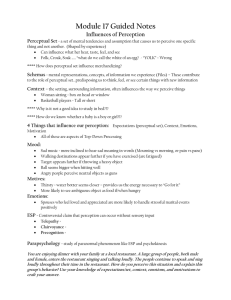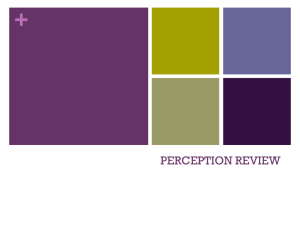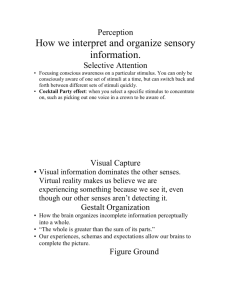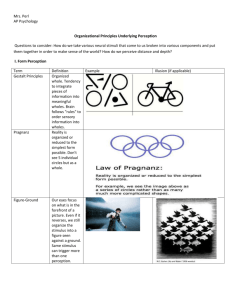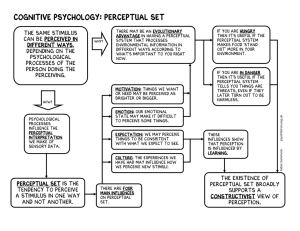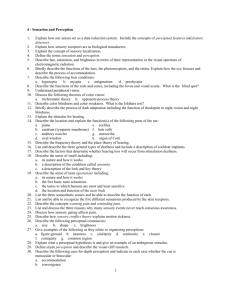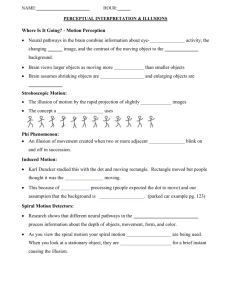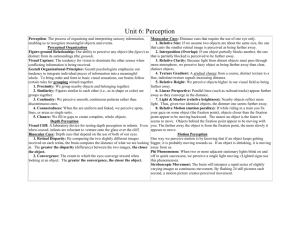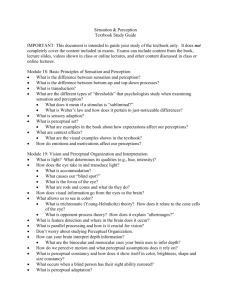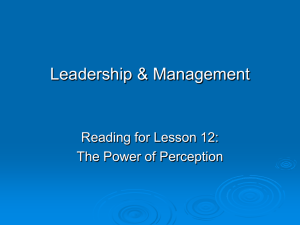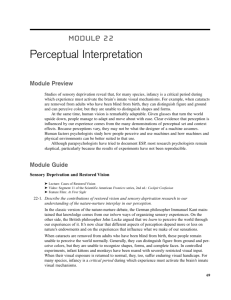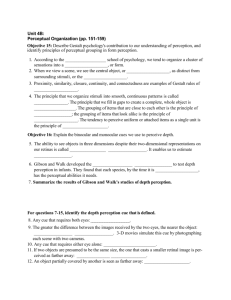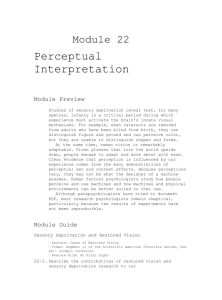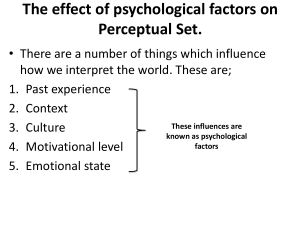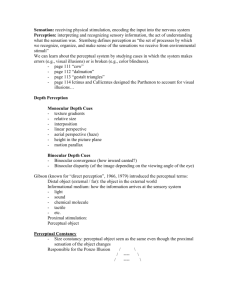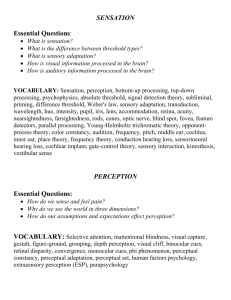PERCEPTION Powerpoint
advertisement
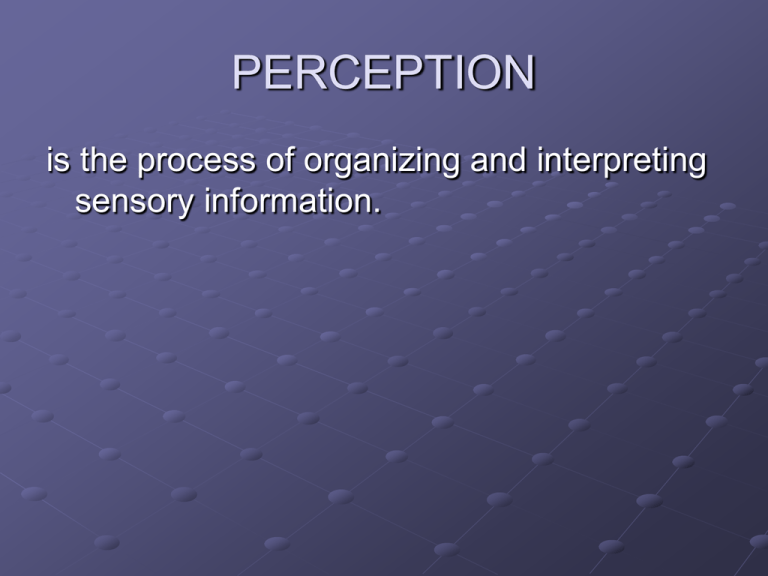
PERCEPTION is the process of organizing and interpreting sensory information. A BIRD IN THE THE HAND Selective Attention The focusing of conscious awareness on a particular stimulus. For example: 1. “the cocktail party effect” 2. in a restaurant when you listen to other people have a conversation. 3. What other examples can you think of? PERCEPTUAL ILLUSIONS Muller-Lyer Illusion Which line is bigger? The Ames Room Visual Capture: vision dominates the other senses. Example: 3D movie, roller coaster ride PERCEPTUAL ORGANIZATION FORM PERCEPTION Figure and Ground-the organization of the visual into objects (the figures) that stand out from their surroundings. (the ground is the background in which the individual stands) -The following slides are examples of figure & ground FORM PERCEPTION Can you see the old woman? Can you see the young woman? Do you see a vase? Or two faces? What do you see in this image? Is this a bunny or is this a duck? Examples of Grouping Grouping-we organize the figure into a meaningful form so that people can make sense of what they see. Figure & Ground (previous slides are examples of- the vase or 2 faces, and the dog) Proximity-group nearby figures together. Similarity-we group together figures similar to one another. Continuity-we perceive smooth continuous patterns rather than discontinuous ones. Form Perception Connectedness-when they are uniform and linked, we perceive spots, lines or areas as a single unit. Form Perception Closure-we fill in the gaps to create a complete, whole object. Depth Perception Is the ability to see objects in 3 dimensions. Binocular cues-depth cues, that depend on the use of two eyes. Examples: 1. Retinal Disparity-by comparing 2 images from the eyeballs, the brain computes distance-the greater the disparity (difference) between the 2 images, the closer the object. -Try the floating finger sausage. Visual Cliff-a laboratory device for testing depth perception in infants. Monocular cues-distance cues available to either eye alone Examples: 1. Relative size-if we assume that 2 objects are similar in size, we perceive the one that casts the smaller image to be further away. 2. Interposition-if one object blocks the view of another, we perceive it to be closer. 3. Relative Clarity-because light from distant objects passes through more atmosphere, we perceive hazy objects as farther away than sharp, clear objects. 4. Texture gradient-a gradual change from a coarse, distinct texture signals increasing distance. Objects further away appear smaller and more densely packed. 5. Relative Height-we perceive objects higher in our field of vision as farther away 6. Relative Motion-as we move, objects that are stable may appear to move. For example: if while riding in a train you fix your gaze on an object-house-the objects closer to the house appear to move backward. The nearer an object is, the faster it seems to move. 7. Linear Perspective-parallel lines such as railroads appear to converge with distance. The more the lines converge, the greater their perceived distance. 8. Light and shadow-nearby objects reflect more light to our eyes. Thus given 2 identical objects, the dimmer one seems farther away. MOTION PERCEPTION Stroboscopic movement is when the brain interprets a rapid series of slightly varying images. By flashing 24 still pictures each second, a motion picture creates perceived movement. (a flip book) The PHI PHENOMENON is created when 2 or more adjacent lights blink on and off in succession, creating the illusion of movement. PERCEPTUAL CONSTANCY Perceiving objects as unchanging, in size, color, shape, brightness, location and light. Is the ability to recognize than object remains the same even when it produces different images on the retina. PERCEPTUAL INTERPRETATION Sensory Deprivation-Infancy is a critical period during which experience must activate the brain’s innate visual mechanisms. Perceptual Adaptation-Human vision is adaptable. Given glasses that shift the world to the left or right or upside down, humans can adapt and see with ease. PERCEPTUAL SET Perceptual Set is the readiness to see objects in a particular way based on expectations, experiences, emotions & assumptions. Perceptual set influences our everyday perceptions. Human Factors Psychology (p255) A branch of psychology that explores how people and machines interact and how machines & physical environments can be adapted to human behaviors. Perceptions vary and may not be what a designer assumes so human factors studies how machines & physical environments can be improved i.e. safety EXTRASENSORY PERCEPTION The claim that perception can occur apart from sensory input. Parapsychology is the study of paranormal phenomena, including ESP (astrology, psychic healing, communication with the dead, out of body experiences. Types: telepathy-mind to mind communication clairvoyance-perceiving remote events precognition-perceiving future events psychokinesis-mind over matter The Ganzfeld Procedure Is the use of sensory deprivation to minimize distractions, hoping to detect faint telepathy signals.
